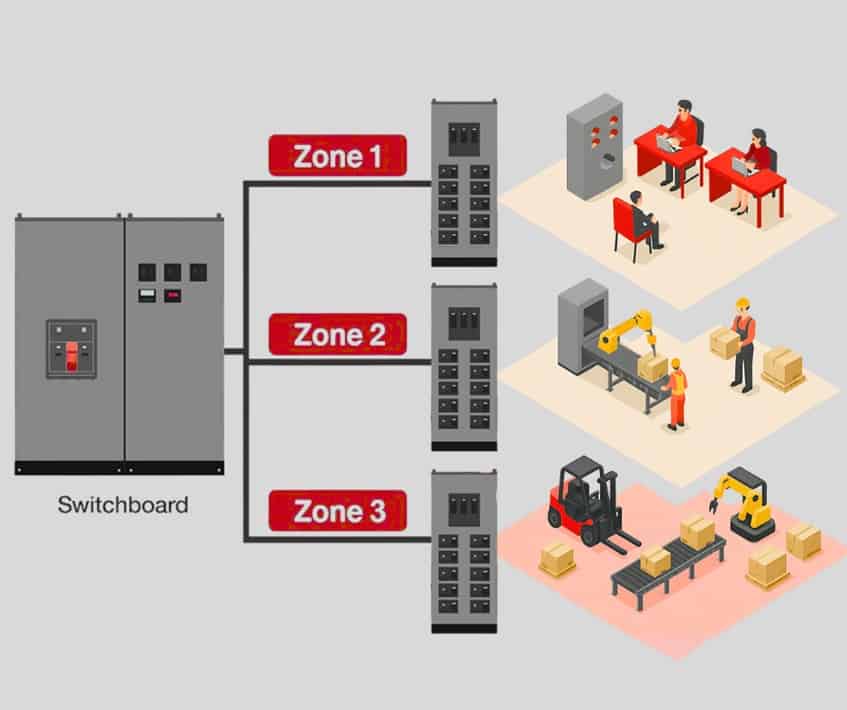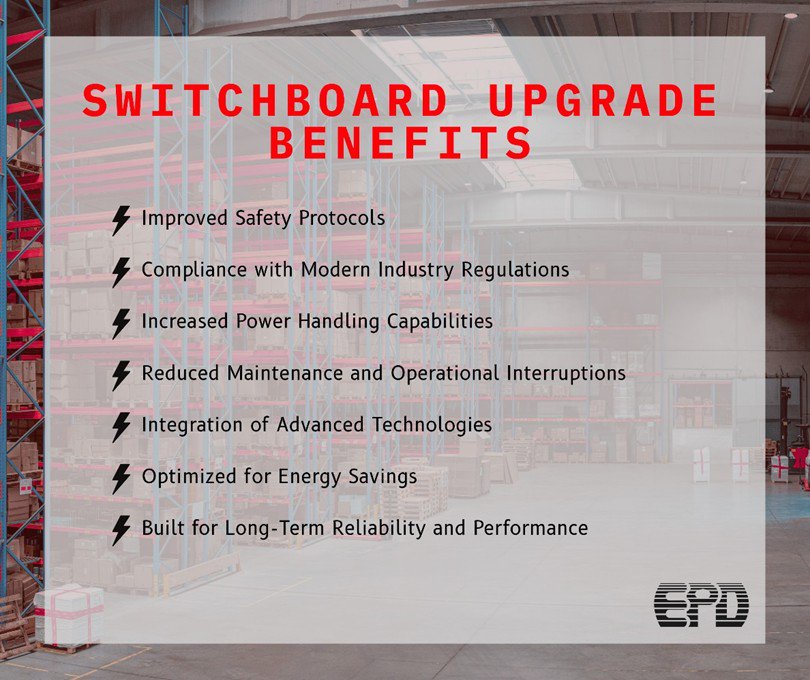Strategies for Minimizing Downtime During Switchboard Upgrades in Industrial Facilities
Switchboard upgrades are essential to keeping electrical infrastructure safe, efficient, and aligned with modern industrial needs. However, in facilities where uninterrupted operations are critical, even brief periods of downtime can lead to production losses, safety risks, and significant financial setbacks.
As an electrical engineer, I can say that the most effective way to minimize downtime during switchboard upgrades in industrial environments lies in proper planning and execution, whether the project involves reconditioning existing equipment or a complete system replacement.
When electrical engineers and facility managers face the challenge of upgrading switchboards without halting operations, the pressure is real. From avoiding unexpected shutdowns to coordinating across teams and maintaining safety, every decision matters. It is time to address those pain points by offering practical, field-tested strategies that reduce disruption, safeguard productivity, and strengthen long-term system reliability.

Understanding Downtime Impact and the Need for Switchboard Upgrades
In industrial facilities, downtime is more than just an inconvenience. Even short periods of electrical system interruption can halt production lines, delay logistics operations, and cause substantial financial losses. The consequences often extend beyond the immediate moment, affecting delivery schedules, workforce productivity, and customer satisfaction.
Why Downtime Matters
Based on my experience and insights from other electrical engineers, industrial operations depend heavily on uninterrupted power to keep automation systems, HVAC units, lighting, and specialized machinery running efficiently. When switchboards become outdated or overloaded, they increase the risk of sudden power failures and inefficiencies. Upgrading these systems is essential to maintain operational stability. However, the process must be handled in a way that avoids costly interruptions.
Strategic Approach to Minimize Downtime
To reduce downtime during switchboard upgrades, facilities should adopt a proactive and well-planned approach.
Some key strategies include:
- Scheduling Upgrades During Off-Peak Hours
Plan major electrical work outside of normal production times or during seasonal lulls
to minimize operational disruption. - Implementing Backup Power Systems
Temporary generators or uninterruptible power supplies (UPS) can keep essential
systems running during upgrade procedures. - Detailed Pre-Upgrade Planning
Develop a comprehensive plan that outlines each phase of the upgrade, identifies
potential challenges, and assigns clear responsibilities to engineering and maintenance
teams. - Stakeholder Communication
Keeping internal teams, contractors, and leadership aligned on project timelines and
responsibilities helps ensure a smooth and coordinated effort.
What Is the Need for a Switchboard Upgrade?
Several warning signs indicate that a switchboard is no longer operating efficiently or safely. Facilities may begin to notice frequent tripping of circuit breakers, flickering or dimming lights, overheating at the switchboard panel, or unexplained surges in electricity usage. These issues often stem from outdated or overloaded components that can no longer handle modern energy demands. In some cases, minor electrical faults may go unnoticed until they result in equipment damage or safety risks. Addressing these symptoms through timely upgrades is essential for maintaining operational continuity, reducing unplanned downtime, and aligning with modern safety standards.

Recognizing that upgrades are not only technical projects but also business-critical operations is the first step toward reducing risk and maximizing long-term return on investment. For facilities seeking a proven partner in managing complex upgrades with minimal disruption, Electronic Power Design offers specialized low voltage switchboard solutions tailored to industrial demands.
Key Drivers of Downtime in Switchboard Upgrades
Understanding what contributes to downtime during switchboard upgrades is essential for developing effective prevention strategies. Industrial facilities are complex environments where even a minor disruption can cascade into significant delays and losses.
1. Equipment Failure
Aging or poorly maintained electrical components are more prone to failure during an
upgrade. Outdated switchboards may not interface smoothly with new technologies,
increasing the risk of operational breakdowns if not carefully assessed and tested beforehand.
2. Inadequate Planning
Insufficient planning is a major contributor to delays. Upgrades often take longer than
expected when timelines, power requirements, or resource availability are underestimated.
This is particularly true if multiple teams are involved without precise coordination.
3. Human Error
Mistakes in installation, testing, or safety procedures can delay commissioning and introduce
unplanned rework. Clear procedures and trained personnel are essential to minimize this risk
during complex electrical transitions.
4. Communication Breakdowns
Effective coordination between engineering teams, contractors, facility managers, and other
stakeholders is critical. Miscommunication about scheduling, system requirements, or safety
protocols can derail an otherwise well-structured project.
5. Supply Chain Delays
Modern switchboards include highly specialized components. Shortages in raw materials like
copper or delays in part deliveries can slow installation and commissioning schedules,
especially in today’s volatile global supply chains.
6. Lack of Preventive Maintenance
Facilities not following a regular preventive maintenance program will likely experience
issues during upgrades. Neglected systems can fail under stress or expose hidden faults once
integration begins.
By identifying these factors early in the planning process, facilities can better anticipate risks,
allocate resources more effectively, and ensure smoother execution.
Upgrade Indicators: Knowing When to Modernize Switchboards
Recognizing the right time to upgrade your switchboard systems is critical for reducing downtime and ensuring operational safety. Postponing necessary upgrades can increase the risk of failures and lead to higher long-term costs.
1. Frequent Maintenance Requirements
If switchboards need frequent repairs or inspections, this often points to aging components and declining system reliability. Repeated maintenance not only disrupts operations but also increases labor and material expenses over time.
2. Outdated Technology
Older switchboards may lack modern safety features, real-time monitoring, or compatibility with automation systems. Without these capabilities, facilities struggle to meet the demands of digital operations and cannot take full advantage of predictive maintenance or smart diagnostics.
3. Poor Energy Efficiency
Inefficient switchboards contribute to higher electricity bills due to voltage drops, energy loss, and suboptimal power factor. Upgrading to energy-efficient systems improves load management and lowers operational costs.
4. Regulatory Non-Compliance
Switchboards that do not comply with current safety and performance standards such as NEC or IEC 61439 can expose facilities to penalties, insurance issues, and audit failures. Ensuring compliance is key to maintaining safety and avoiding legal complications.
5. Safety Hazards
Signs such as overheating, rust, tripped breakers, or visible wear suggest the switchboard may pose a safety risk. Upgrades help reduce the chance of arc faults, fires, and unplanned shutdowns, protecting both personnel and assets.
6. Rising Operational Costs
Unexplained increases in utility costs, frequent interruptions, and repair delays are often symptoms of aging infrastructure. Modernizing switchboards can lead to more predictable performance and reduced unplanned expenses.
By recognizing these signals early, facility managers and engineers can plan ahead and
modernize their switchboard infrastructure in a structured and efficient manner. This not only
minimizes disruptions but also improves system resilience and long-term performance.
Pre-Upgrade Planning: Laying the Foundation for a Smooth Transition
Effective pre-upgrade planning is the cornerstone of minimizing downtime during switchboard upgrades in industrial facilities. Without careful preparation, even well-intentioned projects can lead to costly disruptions, delayed schedules, and operational bottlenecks.
1. Conduct a Facility-Wide Power Assessment
Begin by auditing your current electrical infrastructure to identify existing weaknesses, capacity limitations, and compatibility issues. This helps determine whether a full replacement, partial upgrade, or modular solution is most appropriate for your needs.
2. Engage Key Stakeholders Early
Involve operations managers, electrical engineers, safety officers, and external contractors in the planning phase. Early coordination ensures everyone is aligned on timelines, safety requirements, budget considerations, and operational dependencies.
3. Identify Critical Load Requirements
Determine which systems must remain operational during the upgrade. This includes critical machinery, HVAC systems, security networks, and communication systems. Understanding these needs is essential for selecting appropriate backup power solutions and scheduling work without interrupting core operations.
4. Schedule Work During Low-Demand Periods
Timing is everything. Plan upgrades during weekends, holidays, or off-peak shifts to reduce the risk of business disruption. This strategic scheduling approach also allows contractors more flexibility, which can help shorten overall project timelines.
5. Conduct a Risk and Safety Assessment
Identify potential hazards associated with the upgrade, such as arc flash risks, equipment overload, or short circuits. Develop safety protocols, including lockout-tagout procedures, personal protective equipment (PPE) requirements, and emergency response plans.
6. Establish a Contingency Plan
No matter how well you plan, unexpected issues can arise. Prepare a backup strategy that includes alternate power routing, mobile generators, or quick-swap replacement modules to minimize impact if delays occur.
7. Coordinate with Utility Providers if Needed
If the upgrade affects service from the local utility provider, be sure to coordinate in advance.
Utility involvement may be necessary for de-energizing equipment, rerouting power, or verifying reconnections post-upgrade.
Pre-upgrade planning is not just about logistics, it’s about preparing your facility to navigate change with minimal disruption. A thoughtful, comprehensive plan ensures safety, efficiency, and continuity throughout the upgrade process.
Cost Benefit Analysis: Weighing Downtime Against Long-Term Gains
Before undertaking any switchboard upgrade in an industrial facility, conducting a thorough cost benefit analysis is essential. This process allows facility managers and engineers to balance the financial impact of short-term downtime against the long-term benefits of enhanced safety, reliability, and efficiency.
Understanding the Cost of Downtime
Downtime in industrial settings can be extremely costly. Interruptions to production, shipping, inventory systems, and automation processes can lead to substantial losses. These costs typically include:
- Lost production output and missed delivery deadlines
- Labor costs for idle employees
- Emergency maintenance or repair fees
- Damage to machinery due to electrical faults
- Customer dissatisfaction and revenue loss
Estimating these figures in advance helps justify investment in strategies that minimize
disruptions during the upgrade process.
Calculating Upgrade Investment
The cost of upgrading switchboards includes more than just new hardware. Facility leaders
should account for:
- Equipment costs for new switchboards or modular components
- Installation labor and contractor fees
- Temporary power solutions
- Required downtime for installation and testing
- Compliance upgrades to meet current electrical codes and safety standards
When comparing these costs to the potential savings from improved energy efficiency and
system reliability, the value of the upgrade becomes more clear.
Identifying Long-Term Benefits
A successful switchboard upgrade often leads to significant long-term benefits that far
outweigh the initial investment:
- Reduced maintenance costs due to newer, more reliable systems
- Improved energy efficiency that lowers operational expenses
- Minimized unplanned downtime, improving overall productivity
- Extended equipment life through better load balancing and system protection
- Increased safety and reduced liability from modern arc flash mitigation and code
compliance

Facilities that work with experienced providers like EPD often benefit from custom-engineered switchboards that are optimized for uptime, safety, and lifecycle performance.
Phased Implementation and ROI
To reduce the financial strain of a full shutdown, many facilities adopt phased implementation strategies. This involves upgrading switchboards in stages, allowing the facility to stay partially operational while reducing total downtime.
By combining careful scheduling with long-term performance data, facilities can calculate an accurate return on investment (ROI) and present a compelling case for proceeding with upgrades.
A well-executed cost benefit analysis provides not only financial clarity but also the strategic insight needed to minimize downtime and maximize operational value.
Turning Upgrades into Long-Term Gains
Minimizing downtime during switchboard upgrades is not simply a matter of convenience. It is a critical priority for industrial facilities where even brief interruptions can affect productivity, safety, and profitability. When upgrades are approached strategically, they can be completed with minimal disruption and maximum long-term benefit.
By recognizing early warning signs, developing a detailed pre-upgrade plan, coordinating closely with stakeholders, and incorporating technologies like modular switchgear or temporary power systems, facilities can maintain operations while improving their electrical infrastructure. Each of these elements contributes to a more resilient and efficient system.
Facilities that treat switchboard upgrades as an investment in operational reliability are better equipped to handle future demands. The result is stronger performance, improved energy efficiency, and reduced maintenance over time.
To ensure a smooth and strategic upgrade tailored to your facility’s needs, contact Electronic Power Design today and discover how our solutions support safe, efficient, and future-ready power distribution.
